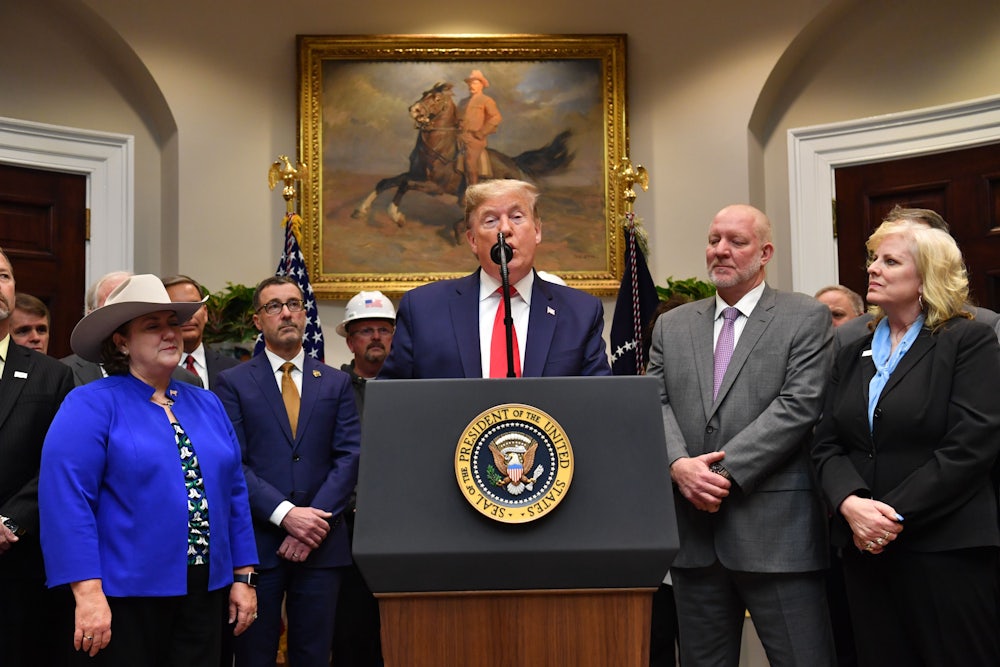On Thursday, the Trump administration revealed its long-touted updates to the National Environmental Policy Act, the Nixon-era law that requires federal agencies to consider environmental and community impacts before approving major infrastructure projects. The result was about as heinous as expected, further codifying the administration’s current ethos of drill first, ask questions later.
NEPA is meant, in design if not always in practice, to act as a legislative safeguard against environmentally harmful practices, like pipelines being routed near major sources of drinking water or mines being operated near active neighborhoods. Still, even as currently enforced, the law has failed to meaningfully prevent environmental justice disparities in marginalized communities, such as the fact that 26 percent of Diné women surveyed in a recent study had high levels of radioactive uranium in their systems from nearby mines. The change necessary, then, is to strengthen the law and its enforcement. The current administration, as expected, has done the opposite.
If cleared, Trump’s new regulations would mean that projects with “minimum federal funding or involvement” could move forward without an assessment of climate impacts. The proposal would also release agencies from having to monitor whether a proposed project would have “cumulative impacts,” which courts have recently ruled include greenhouse gas emissions. Given that scientists from every corner of the globe agree that the world has an ever-shortening window to curb emissions, allowing the extractive industries an easier path to commodify the Earth is extremely alarming.
Unfortunately, none of what the administration has put forward is all that different from how extractive industries already operate—working around the intent of the law to continue poisoning people and the environment—but the proposed regulations would further accelerate these destructive practices. New horizontal drilling operations, natural gas pipelines, and extractive mining operations have all seen upticks since Trump took office, a direct result of his appointment of oil and gas shills to lead the Department of the Interior, Environmental Protection Agency, and Bureau of Land Management.
In recent years, in the absence of strong laws at both the federal and state levels, protests publicizing the disparities in the placement and community impact of these infrastructure projects have been the only halfway dependable routes to actually stopping them.
A recent example of this came on Wednesday, when a three-judge panel on the 4th U.S. Circuit Court of Appeals ruled against the Virginia Air Pollution Control Board’s clearance of a natural gas compressor for Dominion Energy’s Atlantic Coast Pipeline. The pipeline would disproportionately affect a number of marginalized communities along the proposed route, including Union Hill, a historically black community where the compressor station was planned before the town spoke out and sued.
In an eviscerating ruling, the judges offered the following critique of the state’s review process, which more or less describes Trump’s vision for NEPA: “Environmental justice is not merely a box to be checked, and the Board’s failure to consider the disproportionate impact on those closest to the Compressor Station resulted in a flawed analysis.”
As comforting as it would be to believe that these issues start and end with Trump, the reality is that the build-until-they-sue model has long been the default for companies and federal regulators. In one of the more notable instances during the Obama administration, tribes repeatedly sued the U.S. Army Corps over the Dakota Access pipeline, claiming that a potential spill would harm the drinking water for affected tribes and that construction would disturb culturally important burial sites. When the Obama administration and numerous Democratic leaders dragged their feet, protesters from across the country joined the now-famous, Native-led Standing Rock movement in South Dakota. Months of public pressure finally led to Obama filing a lame-duck executive action to block the pipeline. (Naturally, the pipeline was among the first projects revived by Trump when he took office.)
Trump’s NEPA updates—which still have to go through a 60-day public comment window and a pair of public hearings—will almost certainly spur a strong and immediate legal challenge from a consortium of environmental groups, state attorneys general, and tribal nations. Until then, the administration will continue trying to saddle poor and marginalized communities with dirty energy infrastructure, and the world’s doomsday clock will keep ticking down.
